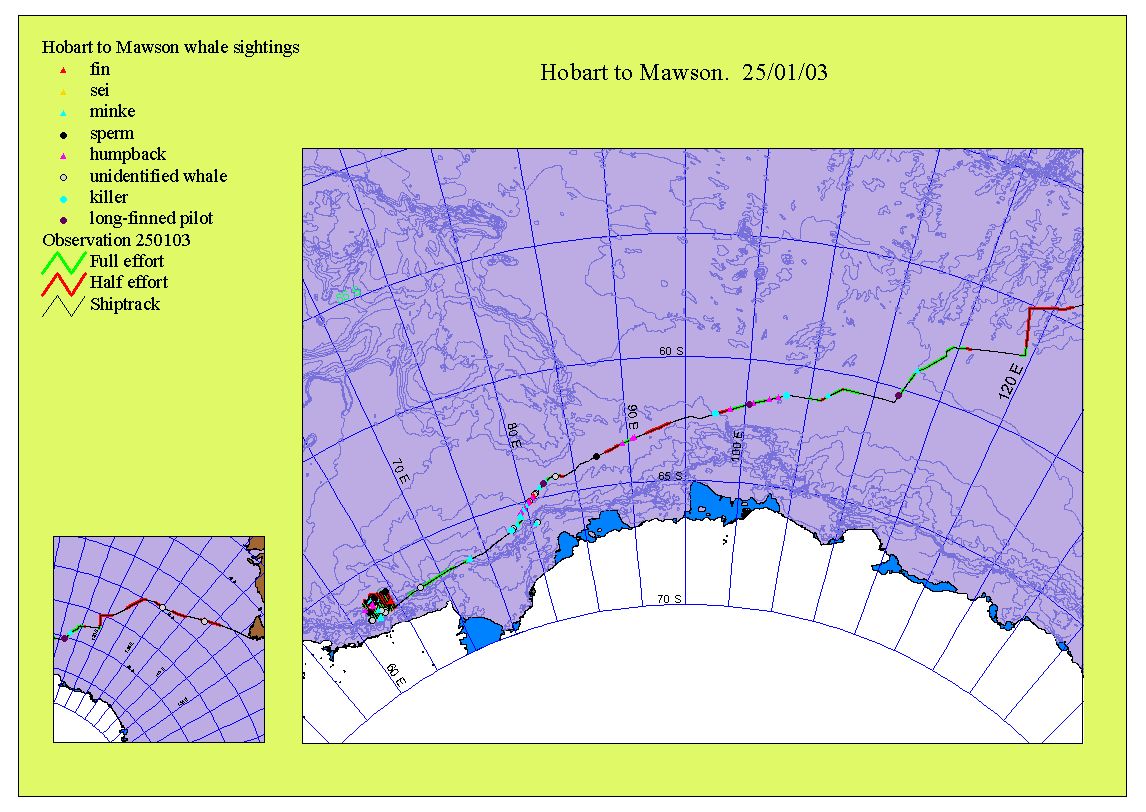Report
#1:
After
last minute panic that the whale acoustics team sonobuoys
would not arrive before scheduled departure, we eventually left
The first few days would be spent steaming to the Australian Antarctic base, Mawson, off which we are to conduct a fine-scale krill survey, as per what we attempted 2 years ago. Unfortunately, during the previous attempt (known as the KACTAS voyage of year 2000/1) we were requested to abort our research half-way through to assist another ship stuck in ice for the past few weeks. The importance of this research to the Commission for the Conservation of Antarctic Marine Living Resources (CCAMLR) led the Australian government to set aside money to re-attempt these studies.
No
sooner had we left the protection of
A trial run with CTDs occurred during the night, which suits us fine as the ship is stationary while they lower the device to the seabed & we can’t conduct our whale survey at ship speeds less than 10 knots (international standard survey techniques). CTD is the acronym for Conductivity, Temperature and Depth recorder. This device gets lowered from a special door in the side of the ship and goes all the way to the bottom recording water data. There is also an ADCP (Acoustic Doppler Current Profiler) attached to the CTD which allows information to be gathered on the current dynamics through measuring the time lapse between echoes from sound pulses emitted into the water column. Then, en route back up from the seabed, electronic messages are sent to the CTD rosette to collect water samples (in special bottles on the instrument) from whichever depth you require the sample. This water is used in a multitude of projects on board, from nutrient and oxygen contents, through to plankton studies.
On the whale side, the voyage down here was pretty Spartan (see Map 1), with three of four sightings a day (one of which, a group of long-finned pilot whales led to the first sound recordings by the whale acoustics team). However, Tuesday the 14th, was an exceptional day:
“After
a good night's sleep due to still waters, I was rudely awoken on Tuesday
morning by a call from the bridge: we were in pack-ice & my colleagues who
had never seen pack-ice wanted to know what to do. So, up I got and
joined them on the bridge to explain ice-types & how to search in this
habitat. Added to the ice everywhere was a very light snowfall - definitely
felt you were in

MAP 1.
The following day (16 January: date of arrival at the ‘krill box’) we had only three whale sightings – what a difference from one day to the next! It will be interesting to correlate this difference to differences in environmental conditions.
In
conclusion, 59 sightings of cetaceans were made during the 11.5 days of transit
from
(You can catch up on
daily details at http://www.aad.gov.au
through the “Southbound” section, or maybe they even have a special page for us
– V4 KAOS [Krill Acoustics & Oceanography Study])
Table 1: Categories of whale sightings made on transect between Hobart & Mawson.
|
Whale
species sighted |
Common
name |
Total number of
sightings: Total number of
animals seen |
|
|
|
|
Balaenoptera physalus
|
Fin whale |
4:6 |
|
Like fin whale |
Like fin whale |
1:2 |
|
Physeter macrocephalus |
Sperm whale |
2:2 |
|
Like sperm whale |
Like sperm whale |
- |
Orcinus orca
|
Killer whale |
|
|
Balaenoptera borealis |
Sei whale |
- |
|
Undetermined species of minke |
Undetermined species of minke |
2:4 |
|
Like minke whale |
Like minke whale |
2:3 |
Balaenoptera bonaerensis
|
Antarctic minke whale |
|
|
Megaptera novaeangliae |
Humpback whale |
|
|
Like humpback whale |
Like humpback whale |
3:4 |
Globicephala melas
|
Long-finned pilot whale |
|
|
Unidentified cetacean |
Unidentified cetacean |
1:1 |
|
Unidentified whale |
Unidentified whale |
2:2 |
|
Unidentified small whale |
Unidentified small whale |
1:1 |
|
Unidentified large whale |
Unidentified large whale |
1:1 |
|
Unidentified baleen whale |
Unidentified baleen whale |
2:2 |
|
Unidentified small baleen whale |
Unidentified small baleen whale |
- |
|
Unidentified large baleen whale |
Unidentified large baleen whale |
3:4 |